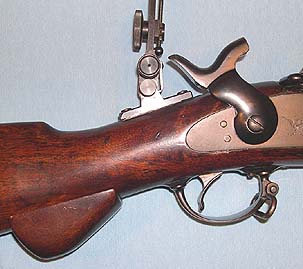A Targetized Trapdoor Rifle
A Targetized Trapdoor Rifle
The following describes and illustrates with photos an original 1884 rifle
.45-70 Springfield which I altered to make it more .user friendly. for
target
purposes at range distances out to 600 yards. This particular rifle had
been reblued and the stock sanded and refinished by a previous owner.
Stocks dents had also been filled with an epoxy compound. Since these
alterations from original condition had been already accomplished I felt
no guilt in further .improving. things for my purposes. In no way do I
recommend that someone alter/devalue an original collectible Springfield
Trapdoor.
I am obviously not a professional gunsmith. Someone who possesses
equipment and skills above and beyond my level could certainly produce a
work of art that would far outshine my efforts. I am, however, pleased
with the intended results of my labors. The rifle shoots very well and it
is more suitable for serious target work. It is fully capable of
producing and has produced scores over the standard Black Powder Cartridge
Silhouette course into the low Master classification. In
"minute-of-angle" terms it will shoot 1.5 to 2.0 MOA consistently with a
"target-tuned" straight black powder load.
The trigger of this rifle is "as issued".. engagement surfaces being
polished a bit and Brownel's "Action Lube Plus" moly lube applied. Pull
weight is around 5-6 lbs. Unseen are randomly placed strips of common
plumber's Teflon tape in the stock barrel channel to "slick" things up a
bit there and allow for unhindered barrel expansion/lengthening as it
heats up during firing. A large "gob" of steel-filled automotive use
epoxy has been applied to the butt plate and shaped to provide a more
"shoulder friendly" surface. It almost appears to be hard rubber. The
shadow cast from the sun in the overall view picture gives clues as to the
actual profile. Sun was over my right shoulder.
Below: Overall view, rifle weighs 9 lbs 3 oz. Approximately one pound
was added by installing a cast linotype rod into the stock.s butt trap
hole (cushioned front and rear). Why there was a butt trap hole in this
stock is unknown to me. The buttplate was solid and had no hinged cover.
Below: Front sight detail. Lyman 17A by Lee Shaver with my own larger
"bubble" assembly. Sorry Mr. Shaver. my eyes are aging and I just could
not see the smaller one well.
Below: Rear Sight Attachment Detail. sight is attached to a steel block
inletted and epoxied into the upper stock wrist. Pardon the Phillips head
machine screws!
The rear sight is an "eastern European" made item purchased from Dixie Gun
Works about mid-1997/98. The sight is mounted to parallel the angle made
by the original Buffington sight which is offset slightly left to
compensate for gyroscopic bullet drift.
Below: Several views showing "pistol" grip knob and other details.. Note
clearance between hammer at full cock and right windage knob on Soule
sight. I may at some future date inlet the sight base deeper into the
stock to permit lower sight elevation. Sight must be almost "bottomed" at
this time to "zero" at 200 yards.
Below: Two views showing partial fake cleaning rod glued (Automotive
"GOOP") into rod channel. Band is pulled forward to reveal tip of rod.
Forward three inches of "rod" is not glued and is bent downward to put
slight pressure on inside lower surface of band to hold barrel positively
in contact with stock.
I hope this has all been interesting and enjoyable.
John Ryckman







